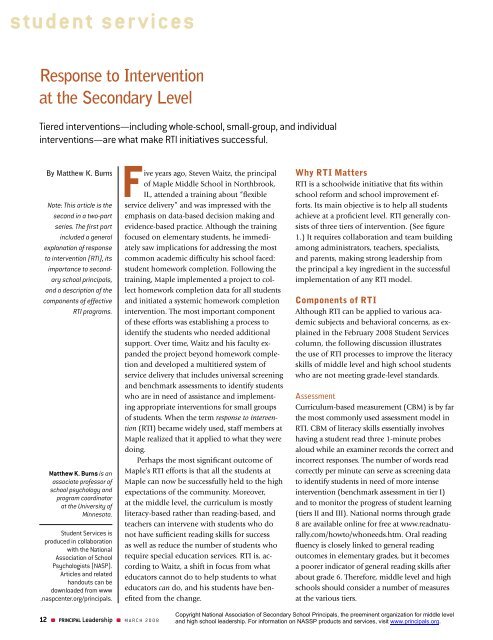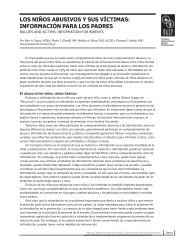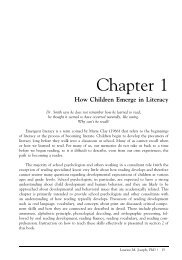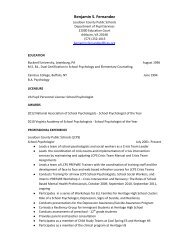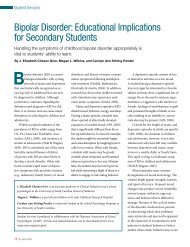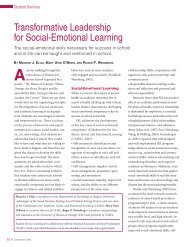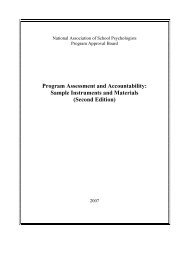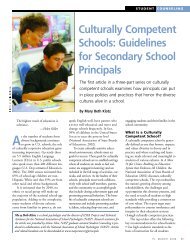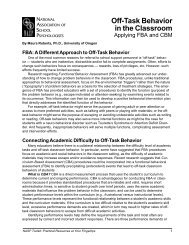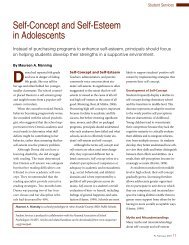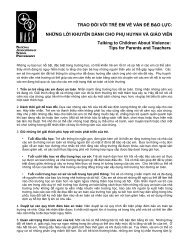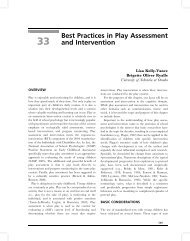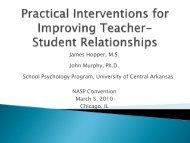Response to Intervention: The Future for Secondary Schools
Response to Intervention: The Future for Secondary Schools
Response to Intervention: The Future for Secondary Schools
Create successful ePaper yourself
Turn your PDF publications into a flip-book with our unique Google optimized e-Paper software.
student services<br />
response <strong>to</strong> intervention<br />
at the secondary level<br />
Tiered interventions—including whole-school, small-group, and individual<br />
interventions—are what make rTI initiatives successful.<br />
by matthew K. burns<br />
Note: This article is the<br />
second in a two-part<br />
series. <strong>The</strong> frst part<br />
included a general<br />
explanation of response<br />
<strong>to</strong> intervention (RTI), its<br />
importance <strong>to</strong> secondary<br />
school principals,<br />
and a description of the<br />
components of effective<br />
RTI programs.<br />
Matthew K. Burns is an<br />
associate professor of<br />
school psychology and<br />
program coordina<strong>to</strong>r<br />
at the University of<br />
Minnesota.<br />
Student Services is<br />
produced in collaboration<br />
with the National<br />
association of School<br />
Psychologists (NaSP).<br />
articles and related<br />
handouts can be<br />
downloaded from www<br />
.naspcenter.org/principals.<br />
12 PrinciPal Leadership March 2008<br />
Five years ago, Steven Waitz, the principal<br />
of Maple Middle School in Northbrook,<br />
IL, attended a training about “fexible<br />
service delivery” and was impressed with the<br />
emphasis on data-based decision making and<br />
evidence-based practice. Although the training<br />
focused on elementary students, he immediately<br />
saw implications <strong>for</strong> addressing the most<br />
common academic diffculty his school faced:<br />
student homework completion. Following the<br />
training, Maple implemented a project <strong>to</strong> collect<br />
homework completion data <strong>for</strong> all students<br />
and initiated a systemic homework completion<br />
intervention. <strong>The</strong> most important component<br />
of these ef<strong>for</strong>ts was establishing a process <strong>to</strong><br />
identify the students who needed additional<br />
support. Over time, Waitz and his faculty expanded<br />
the project beyond homework completion<br />
and developed a multitiered system of<br />
service delivery that includes universal screening<br />
and benchmark assessments <strong>to</strong> identify students<br />
who are in need of assistance and implementing<br />
appropriate interventions <strong>for</strong> small groups<br />
of students. When the term response <strong>to</strong> intervention<br />
(RTI) became widely used, staff members at<br />
Maple realized that it applied <strong>to</strong> what they were<br />
doing.<br />
Perhaps the most signifcant outcome of<br />
Maple’s RTI ef<strong>for</strong>ts is that all the students at<br />
Maple can now be successfully held <strong>to</strong> the high<br />
expectations of the community. Moreover,<br />
at the middle level, the curriculum is mostly<br />
literacy-based rather than reading-based, and<br />
teachers can intervene with students who do<br />
not have suffcient reading skills <strong>for</strong> success<br />
as well as reduce the number of students who<br />
require special education services. RTI is, according<br />
<strong>to</strong> Waitz, a shift in focus from what<br />
educa<strong>to</strong>rs cannot do <strong>to</strong> help students <strong>to</strong> what<br />
educa<strong>to</strong>rs can do, and his students have benefted<br />
from the change.<br />
Why rtI matters<br />
RTI is a schoolwide initiative that fts within<br />
school re<strong>for</strong>m and school improvement ef<strong>for</strong>ts.<br />
Its main objective is <strong>to</strong> help all students<br />
achieve at a profcient level. RTI generally consists<br />
of three tiers of intervention. (See fgure<br />
1.) It requires collaboration and team building<br />
among administra<strong>to</strong>rs, teachers, specialists,<br />
and parents, making strong leadership from<br />
the principal a key ingredient in the successful<br />
implementation of any RTI model.<br />
components of rtI<br />
Although RTI can be applied <strong>to</strong> various academic<br />
subjects and behavioral concerns, as explained<br />
in the February 2008 Student Services<br />
column, the following discussion illustrates<br />
the use of RTI processes <strong>to</strong> improve the literacy<br />
skills of middle level and high school students<br />
who are not meeting grade-level standards.<br />
assessment<br />
Curriculum-based measurement (CBM) is by far<br />
the most commonly used assessment model in<br />
RTI. CBM of literacy skills essentially involves<br />
having a student read three 1-minute probes<br />
aloud while an examiner records the correct and<br />
incorrect responses. <strong>The</strong> number of words read<br />
correctly per minute can serve as screening data<br />
<strong>to</strong> identify students in need of more intense<br />
intervention (benchmark assessment in tier I)<br />
and <strong>to</strong> moni<strong>to</strong>r the progress of student learning<br />
(tiers II and III). National norms through grade<br />
8 are available online <strong>for</strong> free at www.readnaturally.com/how<strong>to</strong>/whoneeds.htm.<br />
Oral reading<br />
fuency is closely linked <strong>to</strong> general reading<br />
outcomes in elementary grades, but it becomes<br />
a poorer indica<strong>to</strong>r of general reading skills after<br />
about grade 6. <strong>The</strong>re<strong>for</strong>e, middle level and high<br />
schools should consider a number of measures<br />
at the various tiers.
Although benchmark assessments through<br />
grade 8 should probably incorporate a CBM<br />
of oral reading fuency, the maze procedure is<br />
probably the best indica<strong>to</strong>r beginning in grade<br />
7 or 8. <strong>The</strong> maze procedure involves having<br />
the students silently read a passage with every<br />
ffth or seventh word deleted. In place of the<br />
deleted word are three choices from which the<br />
student circles the word that best fts the sentence.<br />
Although group tests can be somewhat<br />
helpful <strong>for</strong> screening, progress moni<strong>to</strong>ring data<br />
are important <strong>for</strong> tiers II and III, and group<br />
tests cannot measure progress. As of <strong>to</strong>day,<br />
maze and CBM appear <strong>to</strong> be the most effective<br />
approaches.<br />
In addition <strong>to</strong> CBM of oral reading fuency<br />
and maze, state accountability test results and<br />
data from other group tests should be considered<br />
as part of a secondary school’s benchmark<br />
assessment, as should such important<br />
behavioral indica<strong>to</strong>rs as attendance, discipline<br />
referrals or suspensions, and measures of<br />
school climate <strong>for</strong> the individual student (e.g.,<br />
Comprehensive Assessment of School Environments<br />
by NASSP, 1987).<br />
Three times each year, a data management<br />
team should examine CBM of oral reading<br />
fuency and maze data, students’ results on the<br />
most recent accountability test, and other data<br />
<strong>to</strong> decide which students require more intensive<br />
interventions than what is provided in the<br />
core curriculum.<br />
service delivery<br />
Although many people think of individualized<br />
interventions as the crux of RTI, it is the more<br />
standardized interventions used in tier II that<br />
directly determine the success of the model.<br />
<strong>The</strong> hallmark of tier II is small-group interventions.<br />
Students receive interventions on the basis<br />
of their needs with a standardized approach<br />
Indica<strong>to</strong>rs that rtI may Help Your school<br />
n <strong>The</strong> school did not make aYP.<br />
n <strong>The</strong> student population in your building has high needs (e.g., a high-poverty<br />
environment).<br />
n More than 2% of your student population is referred <strong>for</strong> an initial consideration<br />
of special education eligibility.<br />
n Fewer than 90% of students in your building who are referred <strong>for</strong> special education<br />
are found eligible.<br />
n Students from minority groups are overrepresented in your special education<br />
programs.<br />
Figure 1.<br />
activities associated With the three-tiered<br />
rtI model<br />
STUDEnT<br />
POPUlaTiOn DEScriPTiOn aSSESSMEnT DaTa<br />
Tier i all Students Universal: quality<br />
research-based<br />
core curriculum and<br />
instruction<br />
Tier ii approximately<br />
15%<br />
Tier iii approximately<br />
5%<br />
Targeted: smallgroup<br />
(three <strong>to</strong><br />
six students)<br />
interventions<br />
delivered as part of<br />
general education <strong>for</strong><br />
30 minutes each day<br />
in addition <strong>to</strong> core<br />
reading instruction<br />
Intensive:<br />
individualized<br />
interventions that are<br />
based on problemsolving<br />
models;<br />
could include special<br />
education services<br />
Benchmark assessments<br />
conducted at least three<br />
times per year<br />
Frequent measurement<br />
of the skill defcit and<br />
at least twice-monthly<br />
progress moni<strong>to</strong>ring of<br />
general outcome skill<br />
at least weekly progress<br />
moni<strong>to</strong>ring and frequent<br />
in<strong>for</strong>mal classroom-based<br />
assessments<br />
Source: Burns, M. K., & coolong-chaffn, M. (2006). response-<strong>to</strong>-intervention: role <strong>for</strong> and<br />
effect on school psychology. School Psychology Forum, 1(1), 3–15.<br />
March 2008 PrinciPal Leadership 13
student services<br />
rtI resources<br />
aSSESSMEnT<br />
research institute on<br />
Progress Moni<strong>to</strong>ring<br />
www.progressmoni<strong>to</strong>ring<br />
.net<br />
Edcheckup<br />
www.edcheckup.com<br />
aiMSweb<br />
www.aimsweb.com<br />
national center on Student<br />
Progress Moni<strong>to</strong>ring<br />
www.studentprogress.org<br />
Dynamic indica<strong>to</strong>rs of<br />
Basic Early literacy Skills<br />
http://dibels.uoregon.edu<br />
inTErvEnTiOn<br />
PalS<br />
http://kc.vanderbilt.edu/<br />
pals<br />
intervention central<br />
www.interventioncentral<br />
.com<br />
What Works clearinghouse<br />
www.whatworks.ed.gov<br />
<strong>The</strong> Florida center <strong>for</strong><br />
reading research<br />
www.fcrr.org<br />
Best Evidence<br />
Encyclopedia<br />
www.bestevidence.org/<br />
math/math_summary.htm<br />
rTi in GEnEral<br />
national association of<br />
School Psychologists<br />
www.nasponline.org/<br />
resources/rti/index.aspx<br />
national center on<br />
response To intervention<br />
www.rTI4Success.org<br />
14 PrinciPal Leadership March 2008<br />
<strong>to</strong> interventions. For example, students who<br />
lacked phonic skills might all participate in<br />
the Rewards program by Archer, Gleason, and<br />
Vachon (2005) and those with reading fuency<br />
defcits might participate in Read Naturally by<br />
Hasbrouck, Ihnot, and Rogers (1999).<br />
Tier II interventions at the secondary level<br />
are often implemented in specially designed<br />
courses, but how those courses function depends<br />
on the characteristics of the individual<br />
school. <strong>Schools</strong> that use a 50-minute (or onehour)<br />
course block could provide a course in<br />
remedial reading instruction <strong>for</strong> students who<br />
are struggling readers in addition <strong>to</strong> regular<br />
literacy instruction. A common model used in<br />
high schools is <strong>to</strong> schedule the remedial course<br />
simultaneously with a content area, such as social<br />
studies, and use the social studies curriculum<br />
as the instructional material. For example,<br />
25 minutes might be dedicated <strong>to</strong> content-area<br />
instruction and 25 minutes <strong>to</strong> comprehension<br />
or decoding strategies applied <strong>to</strong> the contentarea<br />
text. This would allow students <strong>to</strong> transfer<br />
back and <strong>for</strong>th between the courses (fexible<br />
grouping) with relatively little disruption.<br />
A block schedule of 90 minutes could<br />
incorporate 30 minutes of reading enrichment<br />
in which students with strong or average<br />
reading skills would read independently and<br />
the teacher could run a small fexibly grouped<br />
remedial intervention in the same room.<br />
Alternatively, a reading specialist could coteach<br />
a course and provide remediation or could run<br />
a small group in a different setting. <strong>The</strong> latter<br />
would allow the reading specialist <strong>to</strong> conduct<br />
three groups, lasting 30 minutes each, within<br />
the same 90-minute block.<br />
Because these are small groups, the tu<strong>to</strong>r<strong>to</strong>-student<br />
ratio should be between 6 and 10<br />
students <strong>for</strong> each instruc<strong>to</strong>r. Thus, one teacher<br />
and one paraprofessional (or two teachers) could<br />
teach up <strong>to</strong> 20 students, or one reading specialist<br />
could pull out up <strong>to</strong> 10 students at any one time.<br />
Problem solving<br />
Problem solving is the basis <strong>for</strong> RTI in that<br />
it involves any set of activities designed <strong>to</strong><br />
“eliminate the difference between ‘what is’<br />
and ‘what should be’ with respect <strong>to</strong> student<br />
development” (Deno, 2002, p. 38). In tier<br />
II, problem solving tends <strong>to</strong> focus on identifying<br />
specifc defcits (e.g., fuency versus<br />
comprehension), but sometimes more-intense<br />
interventions are needed <strong>for</strong> students who are<br />
not successful with the remedial ef<strong>for</strong>ts. In<br />
those cases, a more in-depth problem analysis<br />
is used <strong>to</strong> identify individualized interventions.<br />
This usually involves a collaborative ef<strong>for</strong>t <strong>to</strong><br />
identify the current level of per<strong>for</strong>mance, the<br />
desired level of per<strong>for</strong>mance, and variables<br />
that prevent the student from obtaining that<br />
desired level. At the secondary level, this typically<br />
involves a team of teachers from various<br />
disciplines and instructional or intervention<br />
specialists. <strong>The</strong> actual team membership will<br />
change depending on the student and the<br />
problem, but a few core team members are<br />
needed, such as a remedial teacher, a school<br />
psychologist, and a content-area teacher.<br />
outcomes<br />
Research has consistently found that RTI<br />
initiatives lead <strong>to</strong> gains in student achievement<br />
and schoolwide improvements, such as<br />
reduced referrals <strong>to</strong> and placements in special<br />
education and a higher rate of students scoring<br />
profciently on state tests (Burns, Apple<strong>to</strong>n,<br />
& Stehouwer, 2005). Windram, Scierka, and<br />
Silberglitt (2007) described two secondary<br />
initiatives and found a 66% profciency rate<br />
on a group-administered accountability test<br />
among the 18 high school students who were<br />
considered at risk <strong>for</strong> failing the tests and who<br />
participated in the pilot RTI project.<br />
Moreover, the average growth rate on a<br />
group-administered test <strong>for</strong> those students was<br />
more than three times the national average<br />
among students in grade 9 and more than fve<br />
times their growth from the previous year. A<br />
similar program <strong>for</strong> mathematics in grade 8<br />
led <strong>to</strong> growth rates that exceeded the national<br />
average by a fac<strong>to</strong>r of almost six (Windram,<br />
Scierka, and Silberglitt, 2007). Finally, the<br />
Heartland Area (Iowa) Education Agency 11<br />
(2004) published extensive data regarding its<br />
well-known RTI approach and found high rates<br />
of profciency among middle level and high<br />
school students, but perhaps more important,<br />
it reported a drop-out rate of less than 2%,<br />
which is well below the national average.
conclusion<br />
<strong>The</strong> national education community continues<br />
<strong>to</strong> focus tremendous attention on RTI as an<br />
effective means of improving student achievement<br />
and reducing drop-out rates. <strong>The</strong> U.S.<br />
Department of Education is currently funding<br />
numerous RTI-related research projects<br />
and technical assistance centers, such as the<br />
National Center <strong>for</strong> <strong>Response</strong> <strong>to</strong> <strong>Intervention</strong><br />
(www.rti4success.org). <strong>Schools</strong> throughout<br />
the country are implementing RTI initiatives,<br />
but research is ongoing and implementation<br />
ef<strong>for</strong>ts, especially at the secondary level, are<br />
remarkably inconsistent. Adhering <strong>to</strong> core<br />
RTI components will more likely ensure<br />
successful outcomes. At the secondary level,<br />
these core components are data-based decision<br />
making with multiple sources of data<br />
(including state accountability tests); fexible,<br />
small-group instruction in both skill strategies<br />
and content; and collaborative problem<br />
analysis. PL<br />
reFerences<br />
n Archer, A. L., Gleason, M. M., & Vachon, V.<br />
(2005). REWARDS secondary. Longmont, CO:<br />
Sopris West.<br />
n Burns, M. K., Apple<strong>to</strong>n, J. J., & Stehouwer, J. D.<br />
(2005). Meta-analysis of response-<strong>to</strong>-intervention<br />
research: Examining feld-based and researchimplemented<br />
models. Journal of Psychoeducational<br />
Assessment, 23, 381–394.<br />
n Deno, S. L. (2002). Problem solving as “best<br />
practice.” In A. Thomas & J. Grimes (Eds.), Best<br />
practices in school psychology (4th ed., pp. 37–66).<br />
Bethesda, MD: National Association of School<br />
Psychologists.<br />
n Hasbrouck, J. E., Ihnot, C., & Rogers, G.<br />
(1999). Read naturally: A strategy <strong>to</strong> increase oral<br />
reading fuency. Reading Research and Instruction,<br />
39(1), 27–38.<br />
n Heartland Area Education Agency 11 (2004,<br />
April 1). Heartland AEA 11 annual progress report.<br />
Available online at www.aea11.k12.ia.us/<br />
downloads/2004apr.pdf<br />
n National Association of <strong>Secondary</strong> School<br />
Principals. (1987). Comprehensive assessment of<br />
school environments. Res<strong>to</strong>n, VA: Author.<br />
n Windram, H., Scierka, B., & Silberglitt, B.<br />
(2007). <strong>Response</strong> <strong>to</strong> intervention at the secondary<br />
level: A description of two districts’ models of<br />
implementation. Communique, 35(5), 43–45.<br />
rtI resources<br />
rTi in GEnEral<br />
national association of<br />
State Direc<strong>to</strong>rs of Special<br />
Education<br />
www.nasdse.org/projects<br />
.cfm<br />
<strong>The</strong> council of<br />
administra<strong>to</strong>rs of Special<br />
Education<br />
www.casecec.org/rti.htm<br />
rTi Partnership at<br />
University of cali<strong>for</strong>nia–<br />
riverside<br />
www.rti.ucr.edu<br />
<strong>The</strong> iDEa Partnership<br />
www.ideapartnership.org<br />
national research center<br />
on learning Disabilities<br />
www.nrcld.org<br />
March 2008 PrinciPal Leadership 15


